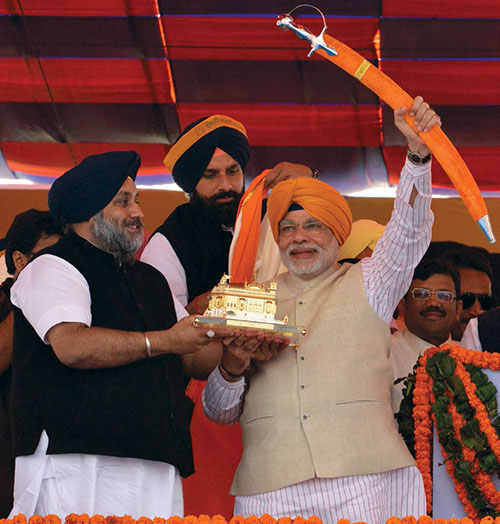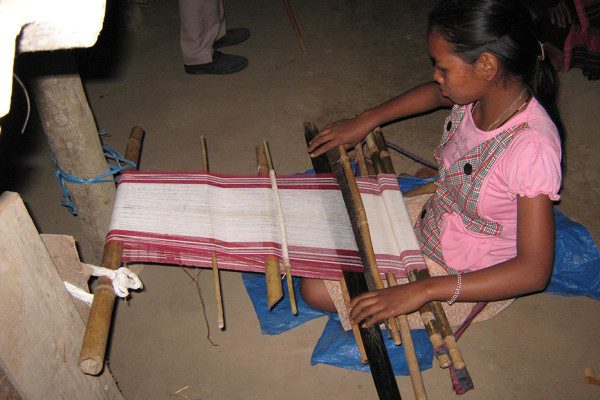With the invention and circulation of cultural symbols, such as Love Jihad, Ghar Wapsi, and ‘Bharat Mata Ki Jai’, there is a persist package of ‘go back’ attempts that intend to repeat the cultural re-imagination of ‘Indian Nationalism’, which was popular in late 19th Century and first half of the 20th Century, says Aejaz Ahmad Wani.
Why is Indian nationalism still an unsettled phenomenon? This question keeps coming up quite often. The rubric of nationalism, at least in India is not a self-sufficient category, more eloquently; it is a political sentiment that draws its ‘life and blood’ from its resources which inter alia include symbols, cultural ethic, certain values that are held pre-requisite in its imagination. Unless these cultural resources are invoked, nationalism, as a sentiment, might go into a banal state.
From a certain standpoint, the present crisis of nationalism in India is, as matter of fact, a contestation between civic nationalism and cultural nationalism. While the former is inclusive variant that is essentially a product of India’s constitutional configuration, based on liberty, equality and rights, the latter is exclusive, a product of particular religious-cultural imagination (for instance Hindutva version) that prioritises one category of people over others.
Even though as Indian nationalism originally emerged as a cultural variant, it nevertheless coincided with a parallel nationalism that always remained secular. What we eventually ended up with was the latter one that registered an ideological supremacy over the cultural one, despite the unfortunate Partition of 1947. Given that India and Pakistan were carved out on religious lines, biases apart, India’s subsequent decision to create a secular country will always be regarded as decision par excellence. It is this legacy that should become an ideological weapon against those who want to repeat the ‘culturation’ of otherwise secular nationalism, which can have unimaginable implications in the foreseeable future.
With the invention and circulation of cultural symbols, such as Love Jihad, Ghar Wapsi, and now the controversy over ‘Bharat Mata Ki Jai’, there is a persist package of ‘go back’ attempts that intend to repeat the cultural re-imagination of ‘Indian nationalism’, which was popular in late 19th Century, by Hindu elites and in the first half of the 20th century by Muslim elites. It was the power of these essential, cultural and primordial explanations of nationalism of both Hindu and Muslim elites that created two nation-states on religious-cultural lines. Ample historical evidences are available in the writings of renowned historians like Gyanendra Pandey, Sugata Bose, Ayesha Jalal and others that illustrate these elitist creations. However, our introductory description throws up two crucial questions. How was cultural nationalism imagined by Hindu and Muslim elites in the 19th and 20th Century which consequently created two states, which was its telos, but with unsettled national issues? Second, why has this cultural re-imagination through symbol politics re-surfaced today even when there are no ‘other or antagonist’ claims around that might compete with it? The following analysis shall address these two questions.Cultural Nationalism and Elitist Manipulation
A renowned political scientist Paul R. Brass’ book Ethnicity and Nationalism: Theory and Comparison’ presents a devastating critique of the primordial explanations on nationalism in South Asia, particularly in India. He argues that ‘ethnicity and nationalism’ are not ‘given’ categories, rather social constructions pertaining to the modern centralising state. Secondly,
Brass argues that these symbols, slogans as cultural resource of nationalism are the creations of the elites of the ethnic groups, dominant as well as marginalised, who manipulate symbols to create fervour that sustains ‘nationalism’.
Construction of Hindi-Hindu-Hindustan, Urdu-Muslim-Islam, Ganapati festival, etc are some of the classical examples of the elitist symbolic creations and manipulations.
Even though, it is apparently evident that elites were largely successful in mobilising people along these lines that ultimately unfolded in Hindu and Muslim communal discourses, it eventually overpowered secular elements of India’s National Movement resulting into the creation of India and Pakistan. In Pakistan, Jinnah’s immediate political choice of secular democracy contradicted the very basis of Pakistan’s own creation, as such, after a momentary hope; its political future has since been dominated by what Marxist scholar Hamza Alavi calls as military-bureaucratic oligarchy, while paying a lip service to Islamic ideology that Pakistan was born with. These elites, especially from Punjab and Sind, have ever been dominant in Pakistan; it is now that the administratively and politically ignored areas are coming up with their own imagination of a nation and nationalism in areas like Baluchistan. Having faced with challenges from within, the elites who rule Pakistan now have constantly been resorting to symbol politics and symbol manipulation to keep ‘Pakistani nationalism’ intact.On the other hand,
India’s post-independent political choice to be secular state has largely been successful because it paid much attention towards the development of civic nationalism pillared deeply in constitution of India, thanks to ‘Nehruvian’ inclusive politics. It is another matter that such efforts have not gone unchallenged.
The post-1990 saw the resurgence of cultural nationalism in India with the rise of BJP, again thanks to the cultural and symbolic manipulation of Hindu elites who used Mandir and Mandal issues to power themselves into the corridors of national politics.
Resurgence of Elitist Symbolic Manipulation in Contemporary India
The second question is more pivotal than the first, but is intertwined with it. Why have elites in India resorted to cultural manipulation now? I would avoid religious explanation; I shall rather attempt to understand the underlying intended or unintended political and economic factors that are seemingly significant in Indian elitist subscription of cultural nationalism in the times of ‘post-nationalism’ we live in.While the upper castes have historically been dominant in India, the post-independent India’s emancipatory politics liberated the hitherto oppressed ‘lower castes’ who now understood the power of their numbers.
Thus, with successive democratic upsurges in India, disadvantaged groups emerged in politics with baptism of fire, changed the political equation of Indian politics forever. With the subsequent political awareness of oppressed castes, they began to unleash their own social and political discourses, celebrating their own cultural ethos and existence. What is now called as Dalit historiography, thanks to Periyar, and Ambedkar, it challenges the upper caste elitist national and cultural discourses. It now controls much of political spaces in India, a venue where it has largely kept the old political elites at bay. To counter this, the largely upper caste parties like BJP, organizations like RSS have resorted to political co-option tactics that Congress have successfully used so far. This is the political dimension. It is conspicuous in their attempts to create organizational linkages with what they call as lower castes, Muslims and so on.
It reconfigured the economic equation in India. It challenged the traditional economic power of the caste elites. Hence, caste elites have been challenged both politically and economically by the rise of new social classes. A number of new developments have taken place in the mean time that made the changed political and economic equation more complex.The political emancipation was made possible by affirmative action policies that benefited the lower castes. It is another fact that they are still subject to humiliation, covert discrimination, violence in the society.
Globalisation, Influences, and Cultural Nationalism
The inbuilt positives of Indian politics have prevented the direct confrontation that new developments could have caused. While the new social castes and classes now dominate politics, the upper castes found new avenue to venture into, in the form of free market, private enterprises and international trade facilitated by globalisation. A number of researches such as by Leela Fernandez, Aseema Sinha, et al. have pointed to the changing situation. Though, this is ostensibly a positive plank of Indian democracy, but the lack of political power is still significant, in spite of all economic preponderance over national politics, for caste elites to maintain their economic position though private means, svry often it is observed that privatisation eats up much of the public resources, or that the economic resources all over the world are disproportionately controlled by elites. This is noticeable in the fact that Dalits have the least presence in private enterprises. With the dimming of global economy, domestic political power could be vital in deciding about the economic choices in the forceable future.
In order to counter this, there is an irresistible desire to acquire political power on the part of elites to maintain their economic position. We have seen in recent times that there have been attempts to do away with the affirmative action policies.
A number of related researches have pointed to these arguments in the recent times. For a good understanding of this phenomenon, one can read empirically backed researches such as Steven Wilkinson and Ashotosh Varshney’s works on communal riot politics, or Paul Brass’ works on Institutionalized riot system in India.With no other way open, caste elites resort to symbols manipulation to galvanise people along cultural nationalism at the expense of constitutionally envisaged civic nationalism. Along the process, people become charged on emotional lines, while the elites capitalise from the political dividends that this charged ambiance throws up.
In sum, it is not argued that elitist manipulation is an empirically correct factor explaining the rise of new cultural nationalism in India in the times of ‘post-nationalism’. Instead, it offers us an avenue on logical and historical basis to understand what has been happening in India more than a hundred years ago, and whether the history is repeating itself today. Symbol manipulation doesn’t provide an immanent help to the people facing real and concrete economic problems, nor does the cultural nationalism that it generates provide a recipe for solving people’s problems. What it will do successfully is engage people in confrontationist politics based on ideas, while their problems multiply.














